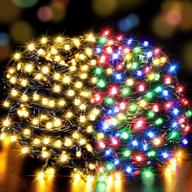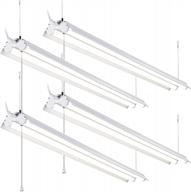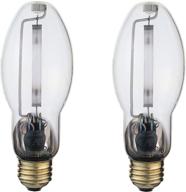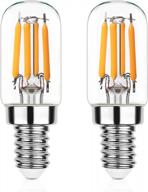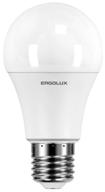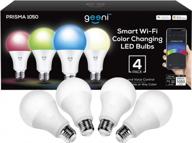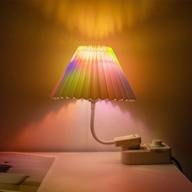Similar products
![cinoton 13w led wall pack light with dusk to dawn sensor, 1600lm[100-277vac/100w hid/hps equiv.] ip65 waterproof outdoor security flood lighting for garage warehouse garden patio 5000k-daylight 1 pack logo](https://images.revain.org/blob/m1u4r2x8_fd2996c6a7@128x128.jpg)

60 Review

Brighter and Longer Lasting Lighting with HID Bulbs
High intensity discharge (HID) bulbs offer significant advantages over traditional incandescent and fluorescent lighting. The technology behind HID lamps enables them to produce more light per watt and have a significantly longer service life.
Greater Light Output
HID bulbs are up to 4 times more efficient than incandescent bulbs. This greater efficiency results in higher light output:
- Metal halide HID - up to 115 lumens per watt
- High pressure sodium HID - up to 150 lumens per watt
- Incandescent bulb - 10-20 lumens per watt
The higher intensity discharge arc in an HID lamp generates this increased light output. HID bulbs also maintain their original lumen output over their lifespan, whereas incandescent bulbs gradually become dimmer.
Longer Lifespan
The average lifespan of an HID bulb is 10,000 to 20,000 hours, compared to just 1,000 hours for an incandescent. This extended lifespan is due to:
- Tungsten filament not being used - no burnout or breakage
- Gas pressure and arc stream regulation maintaining optimal conditions
- Robust bulb materials and construction
| Bulb Type | Average Lifespan |
|---|---|
| Standard Incandescent | 1,000 hours |
| Halogen Incandescent | 3,000 hours |
| CFL (fluorescent) | 8,000 hours |
| HID - Metal Halide | 10,000-20,000 hours |
| HID - High Pressure Sodium | 15,000-24,000 hours |
High Performance Applications
The intensity and longevity of HID lighting makes it ideal for demanding applications where re-lamping costs and interruptions need to be minimized. Typical uses include:
- Warehouses
- Sporting venues
- Manufacturing facilities
- Parking lots and outdoor lighting
- Streetlights
When lighting costs and maintenance are critical factors, HID lamps offer superior illumination over standard bulb options. Their higher lumen output, consistent lighting levels over life, and extended operation result in lower operating expenses over the long run.
Why HID Bulbs Are Better Than Traditional Bulbs
When it comes to lighting performance and value, high-intensity discharge (HID) bulbs offer significant advantages over old-fashioned incandescent and fluorescent lighting. By understanding the benefits, you can make informed decisions for your home or business lighting needs.
More Light Output
HID bulbs produce a greater amount of light per watt compared to traditional bulbs:
- A 400W metal halide HID produces 36,000 lumens.
- A comparable 400W high pressure sodium HID produces 50,000 lumens.
- A 400W incandescent bulb only produces 4,800 lumens.
That's up to 10 times as much light output from HID technology! This increased efficiency makes HID the top choice for large commercial and industrial spaces like warehouses, gymnasiums, and parking garages.
Longer Lifespan
Rather than using a fragile filament, HID bulbs generate light through an arc discharge in a sealed gas medium. This results in an average bulb lifespan of 10,000-24,000 hours compared to just 1,000 hours for an incandescent:
- The City of Phoenix found high pressure sodium streetlights lasted 4-5 years compared to just 1 year for incandescent bulbs, saving on maintenance costs.
- Retrofitting a warehouse with 400W HID fixtures rather than 400W halogens would mean replacing bulbs every 2 years instead of every 3-4 months.
Better Color Properties
HID lighting provides better color rendering and temperature options than old incandescent bulbs:
- High pressure sodium HIDs offer a warm tone perfect for outdoor lighting.
- Metal halide HIDs come in cool or neutral white hues for a crisp, bright light.
- Incandescents have poor color rendering and a warm, yellow/orange glow.
This makes HID a great choice for applications where color accuracy and vision are important, like sports facilities and commercial spaces.
For superior performance, value, and return on investment, high intensity discharge bulbs outshine traditional lighting. Their higher efficiency, longer life, and excellent lighting properties make HID the go-to solution for large, demanding lighting applications.
How HID Bulb Technology Works
High intensity discharge (HID) lamps operate differently than traditional incandescent bulbs. By generating light through an arc discharge between two electrodes, HID bulbs offer greater efficiency and intensity.
HID Bulb Anatomy
HID bulbs contain:
- Two tungsten electrodes inside a quartz glass arc tube
- Inert gas and metals/salts to generate the light arc
- A ballast to regulate electrical current
Generating the Arc Discharge
When power is applied, an electric arc jumps between the two electrodes:
- Current flows through the starter electrode first, ionizing the gas mixture inside the arc tube.
- The arc strikes across to the second main electrode, heating the metallic salts/vapors.
- These materials give off photons, generating intense light.
Top products in 🔦 High Intensity Discharge Bulbs
Maintaining the Arc
Once struck, the arc discharge is maintained and regulated via:
- Control of gas pressure inside the arc tube
- Precise positioning and separation of electrodes
- Ballast regulating the current
These factors allow the arc to operate at optimal temperature and efficiency.
HID Lamp Types
Different HID bulb types use specific gas mixtures to produce their characteristic light:
- Metal Halide - Argon, krypton, xenon, mercury, and metal halides create bright white light.
- High Pressure Sodium - Xenon, sodium amalgam, and mercury vapors result in golden yellow light.
- Mercury Vapor - Mainly just mercury vapor, producing bluish-green light.
Understanding the internal workings of HID bulbs allows matching the technology to lighting needs. Proper fixture design ensures optimal bulb performance.
How HID Lighting Handles Heavy-Use Requirements
High intensity discharge (HID) lamps possess performance characteristics making them ideal for facilities and spaces with high lighting demands.
Extreme Environments
HID bulbs thrive under conditions that cause other bulbs to fail prematurely:
- High bay fixtures in warehouses need to withstand dust and impacts from forklifts.
- Parking lot lights experience large temperature swings and vibrations.
- Gymnasium and stadium lights require moisture resistance.
The quartz glass arc tube and rugged filament electrodes allow HID bulbs to operate reliably despite these challenges.
24/7 Operation
Facilities like hospitals, data centers, and public spaces need constant illumination. With lifespans up to 24,000 hours, HID lamps can burn for years without replacement:
- HID streetlights may only need replacement every 4-5 years compared to incandescent bulbs burning out yearly.
- HID bulbs in a 24-hour industrial facility will outlast metal halide and fluorescent lights 2-3 times over.
This minimizes maintenance interruptions and re-lamping labor expenses.
High Lumens and Efficiency
Large commercial and public venues depend on HID lighting's high output:
- A 400W metal halide HID produces 36,000 lumens, compared to just 5,000 for a 400W high bay fluorescent.
- Stadiums fitted with 1000W metal halide HID fixtures achieve crisp, bright lighting for sports broadcast in high definition.
Lower energy use for equivalent lumen levels also makes HID cost effective.
Safety and Security
HID lamps play an important role in safety:
- Mercury vapor HID lot lights deter crime with high color rendition and zero dark restart time.
- Sodium vapor HID highway lights improve visibility in inclement weather.
Durable, high intensity HID lighting provides 24/7 protection and visibility where it's needed most.
From versatility to high performance, HID technology can handle the toughest lighting challenges.
Picking the Best HID Bulb Type for Your Needs
When selecting a high intensity discharge (HID) bulb, factors like color temperature, color rendering, and lumen output should be considered to match the bulb to your specific lighting application.
Comparing Major HID Bulb Types
| HID Bulb | Light Color | CRI | Lumens | Best Use |
|---|---|---|---|---|
| Metal Halide | Crisp White | 65-90 | 60-115 lm/W | Retail, stadiums |
| High Pressure Sodium | Golden Yellow | 22-65 | 80-150 lm/W | Streetlights, security |
| Mercury Vapor | Blue-Green | 15-65 | 25-60 lm/W | Industrial areas |
Color Temperature
Metal halide ranges from cool (4000K) to warm (3000K). High pressure sodium is very warm at 2100K. Choose based on desired tone.
CRI - Color Rendering
Higher CRI (80-90+) ensures colors are displayed accurately. Important for retail and workspaces. Lower CRI (25-65) is acceptable for outdoor and security lighting.
Lumen Output
Check fixture specifications and space requirements. Gyms and warehouses need high lumen HID bulbs like metal halide and high pressure sodium.
Location and Hours of Use
- High pressure sodium lights parking lots and streets well for long nighttime hours.
- Metal halide illuminates commercial and industrial spaces during business hours.
Choose Bulb and Fixture Together
Ensure the fixture is designed for the HID bulb type. Pairing the wrong HID bulb with a fixture can lead to subpar performance and shorter lifespans.
With the right HID bulb for your lighting needs, you'll get optimal illumination and value. Consult an expert if unsure about making the best match.
How Metal Halide, Sodium, and Mercury Vapor HID Bulbs Differ
High intensity discharge (HID) bulbs utilize different gases and vapors to produce various colors and lighting properties. Comparing the most common types - metal halide, high pressure sodium, and mercury vapor - can help determine the best HID bulb for an application.
Metal Halide HID Bulbs
- Produce bright, white light from 4000K (cool) to 3000K (warm)
- Good color rendering index (CRI) of 65-90
- 60-115 lumens per watt efficacy
- Ideal for retail, hospitals, warehouses, gyms, stadiums
High Pressure Sodium HID Bulbs
- Emit yellow/golden light at around 2100K
- Lower CRI of 22-65
- Very high efficacy of 80-150 lumens per watt
- Used for streetlights, security lighting, industrial spaces
Mercury Vapor HID Bulbs
- Produce blue-green light due to mercury gas emission
- CRI ranging from 15-65
- 25-60 lumens per watt efficacy
- Primarily used in industrial settings
| Bulb Type | Pros | Cons |
|---|---|---|
| Metal Halide | Great color properties, high CRI and neutral white light | Lower efficacy than sodium, requires warm-up |
| High Pressure Sodium | Very high efficacy and lumens, low operating costs | Poor color rendering, warm yellow light |
| Mercury Vapor | Long life, low acquisition cost | Low CRI and lumens, outdated technology |
Evaluate lighting needs, space use, hours of operation, and energy costs when deciding between these common HID bulb types.
Purchasing HID Bulbs with an Amazon Prime Membership
Amazon Prime provides fast, free shipping on millions of items, along with other benefits like streaming media content. This membership program can be useful when purchasing specialty items like high intensity discharge (HID) bulbs for commercial and industrial lighting applications.
Prime Shipping Benefits
Many HID bulbs and fixtures qualify for Prime's free two-day shipping. This allows faster delivery times compared to standard shipping methods. For time-sensitive projects or urgent replacements, two-day shipping can be advantageous.
Prime members also get access to Prime Day deals, exclusive offers, and discounts on HID lighting equipment. Subscribing to Prime just for a major one-time purchase of bulk HID bulbs and fixtures can provide considerable savings to offset the membership cost.
HID Selection on Amazon
Amazon stocks a wide range of HID bulb types and brands, including Philips, Sylvania, GE, and specialty manufacturers. There are options for common wattages and bases like mogul and medium sockets. Amazon has metal halide, high pressure sodium, and other HID varieties.
The selection makes it easy to get replacement bulbs for existing fixtures. And HID fixtures and ballasts are also available through Amazon's marketplace sellers.
A Prime membership can provide fast, free shipping and exclusive discounts on HID lighting supplies. Check any membership terms and conditions to ensure appropriate use.
Understanding The Basics Of Gas Discharge Lamps
Gas-discharge lamps are artificial light sources that generate light by sending an electric discharge through an ionized gas, a plasma. They typically use noble gases or a mixture of these gases, along with additional substances like mercury, sodium, and metal halides. Gas-discharge lamps offer higher efficiency than incandescent lamps, but are more complicated to manufacture and require auxiliary electronic equipment such as ballasts to control current flow through the gas. They also have a perceivable start-up time to achieve their full light output. The discharge lamps work on the fundamental principle that light is emitted when electrons have collided with each other. There are different types of gas discharge lamps available, with essential parameters like output power and pulse durations varying by orders of magnitude.






